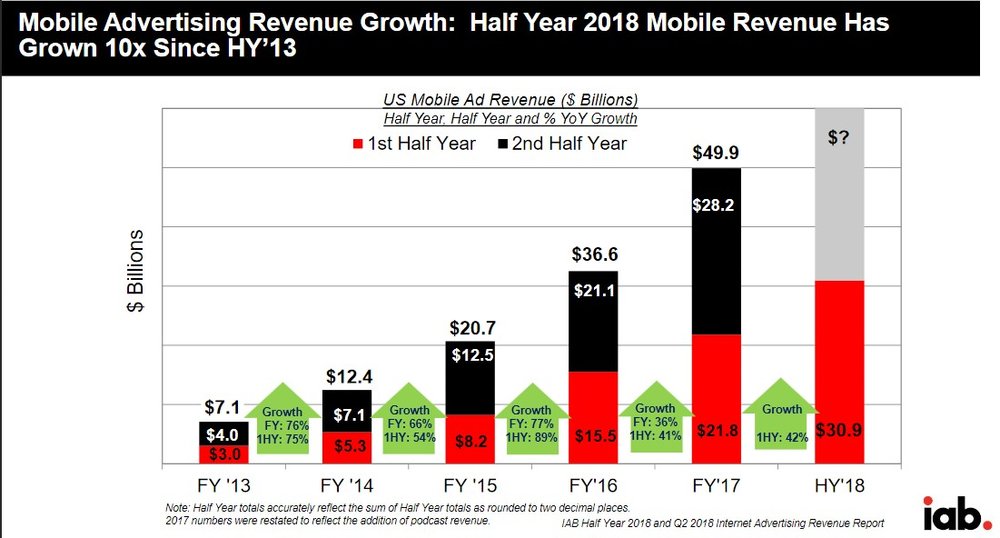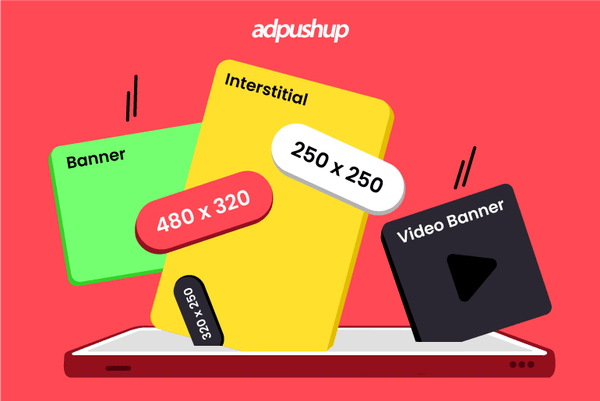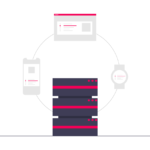In an era where every pixel matters and user experience reigns supreme, mastering the art of ad formats and strategies is not just a choice, but a necessity. Since mobile ads are increasingly becoming popular, trying out different mobile ad sizes is important for publishers trying to achieve the best out of their monetization efforts.
According to a study by Statista, there are 4.66 billion active mobile internet users. That means, almost 78% of all users appear online daily either via mobile web or in-app. This fact inevitably boosts ad growth.
- 29% Of people’s daily screen time is spent looking at smartphones.
- Mobile media time spent is higher at 51% compared to the desktop in the USA.
There are currently 4.68 billion mobile users around the globe. These are users from different geographical locations, of different ages, and statuses (financial and socioeconomic). This creates a huge pool of users and an opportunity for publishers to bring them to their websites and show relevant ads.
Moreover, 70% of world internet usage is on mobile devices. And each individual spends approximately 3 hour 35 minutes on his/her mobile device per day. Therefore, we can infer that mobile advertising is both the present and the future of online advertising.

Image Source: IAB
Now, let’s say you want to give mobile advertising a try. But where to start? What type of ads work on mobile? And what is the best mobile ad size? These are the common questions for every publisher.
Let’s answer these questions, once and for all. Here are the best mobile ad sizes categorized by ad formats to help publishers pick the right one.
Consequently, mobile advertising is significant for brands and advertisers. So, it’s expected many to wonder:
What are Mobile Ad Size (Mobile Advertising Formats)?
Mobile ad size refers to the dimensions and layout of advertisements specifically designed to be displayed on mobile devices, such as smartphones and tablets. It plays a critical role in the overall effectiveness of a mobile advertising campaign, as the size and format directly impact how well the ad captures user attention and fits within the constraints of mobile screens.
There are plenty of mobile display ad sizes available for publishers to use on their website, let’s have a look at some of them.
Top 10 Best Mobile Ad Sizes for Increased Viewability
1. In-app Ads
The most significant advantage in-app ads bring is the amount of time that users spend with applications. According to eMarketer, 89% of mobile usage time is spent in-app.
Alongside this, in-app ads provide a better user experience. Even though ‘nobody likes ads’, apparently, some advertising is more tolerable and even found attractive and likeable than others. With this in mind, advertisers can focus on in-app ads to create better ad experiences.
Being less distracting, highly interactive and engaging, better controlled and managed in-app advertising keeps attracting the interest of advertisers and brands. Along with the growing army of app users, advertisers’ interest and willingness to invest in in-app ads keep increasing, too.
A study conducted by Forrester found that 70 per cent of advertisers and agencies spending at least $1 million every month on digital advertising are going to increase their in-app ad budgets in the following 12 months.
In-app ads are a great solution to address various goals: increase conversions, user retention and engagement, brand awareness, and drive overall revenue generation. Plus in-app ad fits nearly every vertical, from social media, news and entertainment apps, to
2. Mobile Banner Ads
Mobile banner advertising is the most common mobile ad size due to its simplicity and possibility to yield higher CPM’s thoughtful placement. Mobile ad banners are displayed in static ad units, often placed at the top or bottom of the screen of the device.
Mobile banner ad sizes may vary, but the most standard banner sizes are 320×480, 300×250 and 320×50 for smartphones and 728×90, 768×1024 and 300×600 mobile ad units for tablets.
One of the most popular mobile banner ad sizes is a 320×50 mobile ad. Its success is due to its low price for advertisers. Big brands can leverage its minimal space for mobile ad campaigns focused on increasing brand awareness, while mid-size and small brands still can use this banner size to put the essential information about their offer. Plus it provides a great user experience, as a mobile banner is non-intrusive and doesn’t interrupt users from the content.
Mobile ad banner design requires a careful balance between eye-catching and bringing too distracting experience. Best mobile banner ads should highlight key features or provide an offer with a clear and compelling call to action without too much text though.
3. Native Ads
Native advertising on mobile appears in different sizes and forms. As it comes from the name, native ads are user-centric and organically fit into the context of the place where it appears. Accordingly, this format is perceived as relevant, useful information in the flow that increases the chances for the ad to be clicked on.
Native ad imitates the appearance of the contextual environment, so its sizing might also be inherited, but it can be harder to access the demand, so it might be better to try out 320×480, 300×400 or other typical sizes.
4. Mobile Video Ads
Mobile video ads are represented by pre-, mid- or post-roll videos seamlessly appearing in the accordant place of the video. It’s supposed to be 320×480 or 480×320 sizes for smartphones and 768×1024 or 1024×768 for tablets. Also, 320×250 sizing is acceptable for outstream videos.
A typical video ad runs for 15 or 30 seconds when the user taps to play. With the growing popularity of shooting vertical video (mainly for social media), video ads also evolved to both horizontal and vertical options.
Accurate placement of mobile video ads can boost the high engagement of the audience. Specifically, placing it at a natural break in the users’ app journey is a good practice. Also, advertisers should think creatively when introducing a video to the users, as an attractive preview screen encourages users to play the video. To minimize the risk of frustrating the users, it’s a common practice to serve autoplay video with muted sound letting users turn it on and off.
Mobile video ads are the best way to engage your audience and ensure your brand’s presence at the point of purchase. This ad type works great when appearing in native environments and is similar to all the other content in terms of format and style, like on social and regular media.
5. Mobile Rich Media Ads
Mobile rich media ad formats can be represented by videos, GIFs, audio, and other content leading the user to interact with the ad inside the mobile ad units without transitions to other pages or sections.
They can have numerous animated effects like expanding, unfolding, parallax, floating, and more, or stimulate the user’s actions, for instance, “scratch”, swipe or shake the image on the screen, thereby boosting the conversion.
As rich media ads are designed to catch the eye and engage, this may also pose an intrusive threat. Therefore, it is crucial to make sure that creativity doesn’t go overboard.
On the other hand, according to IAB survey, interactive banners are 25% more likely to recall an ad than those exposed to static banners.
6. Interstitial ads
A mobile interstitial ad is a full-screen advertisement that can be interactive and is displayed at the transition points like loading or closing the app, between game levels, while pausing or when the user is trying to switch the section in the app.
The most common sizes of interstitials are 320*480 and 480*320 for smartphones and 1024*768 and 768*1024 for tablets.
Interstitial mobile ads are adopted straight from the web and fit mobile devices perfectly. With this format, advertisers win users’ undivided attention and don’t have to worry about wrong click-throughs, as ads appear in between pages only without interrupting the user.
The interstitial mobile ads allow advertisers to create mobile ad campaigns fueled with beautiful and engaging content with high-quality visual and compelling copy. This can reduce the disruption factor for users. However, this type of ad needs to be managed properly in order to avoid the excessive frequency of views.
Talking about the performance of this ad format, it has 2-3x higher CTR compared to banner ads.
7. Mobile Swipe Ads
Mobile Swipe is hugely adaptable and can be used in many ways, like highlighting a product, demonstrating its usage or performing a product tour. Using habitual interaction with mobile devices, swiping, this format invites users to swipe through the images, each of which goes as a single ad unit and with a link to its own landing page.
8. Scratch Banner Ads
Similarly to lottery tickets where you need to scratch the shiny upper layer with a coin to reveal a prize, a mobile scratch banner ad engages users to do that digitally. Using a finger, a user “scratches” the banner on the mobile screen and reveals the image beneath.
9. Mobile Cube Ads
Being one of the most popular ad formats, the mobile cube allows advertisers to showcase up to six images and a video on its six sides. A cube can spin automatically or by swiping, engaging users to interact with one of the ad messages.
10. Rewarded Video Ads
Rewarded video ads offer users a value exchange- a free in-app reward for watching a video advertisement. The popularity of in-app purchases has been strongly linked to rewarded video Ads being one of the most preferred ways of mobile advertising. According to studies, 71% of players prefer watching in-app video ads rather than spending money on in-app purchases.
Additionally, 52% of mobile game developers admit that rewarded video ads are their most popular form of in-app advertising.
Rewarded Video Ads aren’t only for games. The idea is that your application needs to offer a benefit to the watcher.
The length is between 15 to 30 seconds for most platforms, including Facebook and Instagram. On the other hand, Google can allow a Rewarded Video Ad to be up to 60 seconds.
Typically, the longer the video, the more the user gets rewarded. As a publisher, you should remember that your advertisement gets 15 to 30 seconds of undisrupted play, and if you do it right, that time is more than enough to convince someone to tap on the link and download your application.
Also Read – AdBlock Plus Updates: Mobile ads that won’t be blocked
Conclusion
As we always say, there’s no one-size-fits-all solution in Adtech. You should have a data-driven approach. You should explore, experiment, and then settle on the right ad formats and ad sizes that yield higher CPMs and enhance the user experience as well.
Whether you are using display ad networks or programmatic sellers (SSP), this piece will come in handy. We’ve listed all the best mobile ad sizes and mobile ad formats you can try in 2022. It’s up to you to pick the suitable ones.
FAQs: Mobile Ad Size
Mobile banner ad sizes may vary, but the most standard banner sizes are 320×480, 300×250 and 320×50 for smartphones and 728×90, 768×1024 and 300×600 mobile ad units for tablets.
It’s supposed to be 320×480 or 480×320 sizes for smartphones and 768×1024 or 1024×768 for tablets. Also, 320×250 sizing is acceptable for outstream videos.
Let’s look at the available types of ads for smartphone users.
a) In-app Ads
b) Mobile Banner Ads
c) Native Ads
d) Mobile Video Ads
e) Mobile Rich Media Ads
f) Interstitial Ads
g) Mobile Swipe Ads
h) Scratch Banner Ads
i) Rewarded Video Ads

Deepak has a keen eye for detail and a deep understanding of the ad tech landscape. Whether it’s through in-depth articles, thought-provoking insights, or compelling storytelling, he’s dedicated to helping people navigate the complex world of ad tech with the simplicity of his words.





![CTV vs OTT Advertising: Which one is Right Pick for Publishers? + [6 Bonus Strategies] Ott vs Ctv](png/featured-image-270x180.png)


